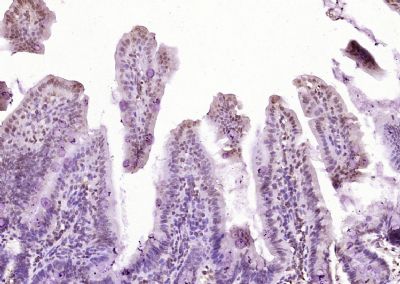NPEPPS Polyclonal Antibody
Purified Rabbit Polyclonal Antibody (Pab)
- SPECIFICATION
- CITATIONS
- PROTOCOLS
- BACKGROUND

Application
| IHC-P, IHC-F, IF, ICC, E |
|---|---|
| Primary Accession | P55786 |
| Reactivity | Rat, Pig, Dog, Bovine |
| Host | Rabbit |
| Clonality | Polyclonal |
| Calculated MW | 103 KDa |
| Physical State | Liquid |
| Immunogen | KLH conjugated synthetic peptide derived from human NPEPPS |
| Epitope Specificity | 201-300/919 |
| Isotype | IgG |
| Purity | affinity purified by Protein A |
| Buffer | 0.01M TBS (pH7.4) with 1% BSA, 0.02% Proclin300 and 50% Glycerol. |
| SUBCELLULAR LOCATION | Cytoplasm. |
| SIMILARITY | Belongs to the peptidase M1 family. |
| Important Note | This product as supplied is intended for research use only, not for use in human, therapeutic or diagnostic applications. |
| Background Descriptions | Puromycin-sensitive aminopeptidase is a 100kDa zinc metallopeptidase which degrades neuropeptides by removing amino acid residues from the amino-terminus. The protein is the most abundant aminopeptidase in the brain, however it is not exclusive to that organ. It is localized primarily in the cytoplasm, and plays a role in the metabolism of neuropeptides in nerve terminals and synaptic clefts. The human PSA gene maps to chromosome 17q 2-32. |
| Gene ID | 9520 |
|---|---|
| Other Names | Puromycin-sensitive aminopeptidase, PSA, 3.4.11.14, Cytosol alanyl aminopeptidase, AAP-S, NPEPPS, PSA |
| Target/Specificity | Detected in liver, epithelium of renal tubules, epithelium of small and large intestine, gastric epithelial cells, and alveoli of the lung (at protein level). |
| Dilution | IHC-P=1:100-500,IHC-F=1:100-500,ICC=1:100-500,IF=1:100-500,ELISA=1:5000-10000 |
| Format | 0.01M TBS(pH7.4), 0.09% (W/V) sodium azide and 50% Glyce |
| Storage | Store at -20 ℃ for one year. Avoid repeated freeze/thaw cycles. When reconstituted in sterile pH 7.4 0.01M PBS or diluent of antibody the antibody is stable for at least two weeks at 2-4 ℃. |
| Name | NPEPPS |
|---|---|
| Synonyms | PSA |
| Function | Aminopeptidase with broad substrate specificity for several peptides. Involved in proteolytic events essential for cell growth and viability. May act as regulator of neuropeptide activity. Plays a role in the antigen-processing pathway for MHC class I molecules. Involved in the N-terminal trimming of cytotoxic T-cell epitope precursors. Digests the poly-Q peptides found in many cellular proteins. Digests tau from normal brain more efficiently than tau from Alzheimer disease brain. |
| Cellular Location | Cytoplasm, cytosol. Nucleus |
| Tissue Location | Detected in liver, epithelium of renal tubules, epithelium of small and large intestine, gastric epithelial cells, and alveoli of the lung (at protein level). |

Thousands of laboratories across the world have published research that depended on the performance of antibodies from Abcepta to advance their research. Check out links to articles that cite our products in major peer-reviewed journals, organized by research category.
info@abcepta.com, and receive a free "I Love Antibodies" mug.
Provided below are standard protocols that you may find useful for product applications.
If you have used an Abcepta product and would like to share how it has performed, please click on the "Submit Review" button and provide the requested information. Our staff will examine and post your review and contact you if needed.
If you have any additional inquiries please email technical services at tech@abcepta.com.













 Foundational characteristics of cancer include proliferation, angiogenesis, migration, evasion of apoptosis, and cellular immortality. Find key markers for these cellular processes and antibodies to detect them.
Foundational characteristics of cancer include proliferation, angiogenesis, migration, evasion of apoptosis, and cellular immortality. Find key markers for these cellular processes and antibodies to detect them. The SUMOplot™ Analysis Program predicts and scores sumoylation sites in your protein. SUMOylation is a post-translational modification involved in various cellular processes, such as nuclear-cytosolic transport, transcriptional regulation, apoptosis, protein stability, response to stress, and progression through the cell cycle.
The SUMOplot™ Analysis Program predicts and scores sumoylation sites in your protein. SUMOylation is a post-translational modification involved in various cellular processes, such as nuclear-cytosolic transport, transcriptional regulation, apoptosis, protein stability, response to stress, and progression through the cell cycle. The Autophagy Receptor Motif Plotter predicts and scores autophagy receptor binding sites in your protein. Identifying proteins connected to this pathway is critical to understanding the role of autophagy in physiological as well as pathological processes such as development, differentiation, neurodegenerative diseases, stress, infection, and cancer.
The Autophagy Receptor Motif Plotter predicts and scores autophagy receptor binding sites in your protein. Identifying proteins connected to this pathway is critical to understanding the role of autophagy in physiological as well as pathological processes such as development, differentiation, neurodegenerative diseases, stress, infection, and cancer.


